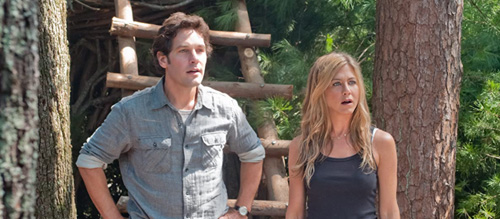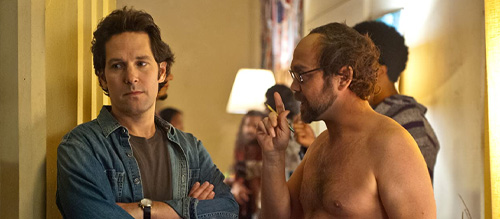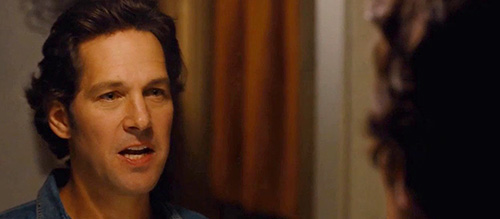‘Wanderlust’ and Its ‘Bizarro Cut’ at 10: How David Wain Split His Sensibility in Two for the Studio System
David Wain’s work as a film director has always stood out within the onslaught of raunchy studio comedies released throughout the 2000s and into the early 2010s. Tracing his sensibility all the way back to ‘The State’ – an NYU comedy troupe turned MTV cult hit show – there is a consistent absurdity and self-referentiality that shines through in each of the 6 studio films he has directed. Honoring his sketch roots and cementing his filmic absurdity with his directorial debut Wet Hot American Summer, a spectrum was thus set in place: one end representing an absolute absurdity, the other representing a more traditional and plot-driven comedy style, each of his films occupying a unique place within it. In February of 2012, Wain’s underrated Wanderlust, ostensibly a typical studio rom-com starring Paul Rudd and Jennifer Aniston, was released into theaters. 10 years later, how does it fare against the rest of Wain’s filmography? Where does it land on the aforementioned spectrum of absurdity?

Wanderlust follows George and Linda Gergenblatt (Rudd and Aniston), who, in the span of what seems like a few days, are forced to sell the New York City apartment they just bought after losing any prospect of work in the city. On their way to stay with George’s crass but successful brother Rick (played by ‘State’ member and the film’s co-writer Ken Marino), they pull into an ostensible bed and breakfast called Elysium, whose overwhelming hospitality they cautiously accept. It turns out that Elysium is a commune, the free-wheeling values of which directly contradict the uptight New York lifestyle George and Linda had been living. After a short stay with Rick and his family, George becomes fed up with Rick’s constant bragging and harassing, and they return to Elysium to lead a more enlightened life.
As much as the film’s premise and even trailers might lead you to believe that Wanderlust would place firmly on the more traditional end of the spectrum, all of Wain’s trademarks are here: it has a handle on its plot while still pausing to take time for more non-sequiturs; it has an expansive cast of expert sketch comedy professionals, many of whom featured in ‘The State’ and throughout Wain’s filmography; its visual creativity is consistent with its comedic ingenuity; it even continues Wain’s trend of utilizing in-jokes between films, drawing your attention to the voice behind the film who will not let you forget his desire to subvert. It is a consistently funny and farcical take on a relatively generic premise, with an energetic boost from its stacked cast.
However, an additional layer to Wanderlust was unearthed via the release of the film’s DVD/Blu-Ray, which saw the inclusion of Wanderlust: The Bizarro Cut. The Bizarro Cut is something of a B-side to the theatrically released cut. It is the same story made up of entirely different takes and jokes, as well as full deleted scenes, presented as its own film entirely. Before we dig deeper into that, though, there are a few factors in the preceding decade of American studio comedies that allowed this to happen.

Another comedic auteur and titan of American cinema in the 2000s was film director and Wanderlust producer Judd Apatow. Often criticized for his excessive runtimes, Apatow’s films often saw their actors improvising lines and riffing with one another on camera in order to achieve a more naturalistic interplay between characters. This was such a staple in his filmmaking in this decade, in fact, that the DVD releases of the films he produced and directed included not only extended “Unrated” cuts of the films, but the special features were loaded with gag reels and what the film crews referred to as “Line-o-Ramas,” which were supercuts of unused jokes that the actors improvised on set. The theatrical cut of Wanderlust, which is Wain and Apatow’s only collaboration, owes a lot to Apatow’s increasingly influential style of comedic filmmaking, while the existence of the Bizarro Cut owes a lot to how that style was capitalized upon in their home video marketing. All of this is relevant in order to note that Wanderlust’s Bizarro Cut is not the first of its kind – in fact, the Apatow-produced Anchorman did the same thing with Wake Up, Ron Burgundy: The Lost Movie, and Wain’s own Wet Hot American Summer DVD release featured a “Fart Track,” which presents the film with additional fart sounds inserted throughout – but moreso to place Wanderlust in the context of American studio comedies at the time, and see how its craft is specifically deepened by the existence of the Bizarro Cut.
Having seen the Bizarro Cut, you experience the theatrical cut in a new way, seeing the obvious improvisational edge that is in each non-exposition-related delivery – the Bizarro Cut, of course, does its best to be rid of any and all plot semblance, speeding its way to Elysium within minutes where the theatrical cut takes more time with its set-up – which makes the film even funnier and more exciting to watch. To return to the absurdity spectrum posited in the first paragraph, Wanderlust’s theatrical cut feels like it is dead in the center, constantly threatening to become generic before it’s jerked back toward the ludicrous. The Bizarro Cut, on the other hand, lies on the furthest end of the absurd side, holding no obligation to any studio-mandated notes and thus being allowed to intentionally and comedically alienate its audience. The unhinged comedic bits that you see in the Bizarro Cut are reined in for the theatrical cut, as they would risk narrative confusion. Ken Marino’s Rick, for example, is not going to “jokingly” beg his brother to fellate him and threaten suicide in front of his family in the theatrical version, because it may alter the audience’s ability to stay grounded in the story. It is even fair to ask if these jokes are as successful as those that make it into the theatrical cut, but that’s precisely where the film’s improvisational edge comes from.
That is not to say that the Bizarro Cut is without craft: it employs a tongue-in-cheek wrap-around narration from Alan Alda’s character that gives the whole thing a sense of structure while still being purposefully incongruous. In fact, the Bizarro Cut is quite valuable as a lesson on the comedy writing process at large: many of the jokes land successfully after having seen the theatrical version because they are such boiled down, borderline structureless versions of the ones we’ve seen in that cut. As intentionally oblique as Wain made the Bizarro Cut, the two versions as a package deal highlight each other’s strengths, the theatrical cut’s biggest of which is its ability to balance the uncut absurdity of the Bizarro Cut with digestible pacing and structure.

It also appears as though Wain wants you to be constantly aware of his craft, as the Bizarro Cut is – like much of his work – authentically meta, drawing attention to the people behind the camera as often as possible. Some examples of this included Aniston’s Linda literally watching the Bizarro Cut on her video camera (the original cut has her watching videos of herself and George as she misses him in what registers as an emotional scene, instead); her same character being asked about depressing films by a child from the commune, eventually asking about Wain’s own The Ten, which she calls “painfully unfunny”; and callbacks to songs from both Wet Hot American Summer and Role Models for fans of Wain’s previous work. All of these factors and examples, while successfully absurd, mesh perfectly with the comedic world that Wain sets up via the Bizarro Cut’s editing and performances, especially that of Paul Rudd, who is at a career best here, because it makes space for his perfect combination of commitment to the role as well as commitment to making people on set laugh in a tongue-in-cheek way. His famous mirror monologue, in which he psyches himself up for intercourse, is something that seems to have worked its way from the Bizarro Cut into the theatrical cut unscathed, precisely because it is evidently born from improvisation.
10 years out from Wanderlust’s release, it feels like a quaint and underappreciated studio comedy, which has become increasingly rare as Hollywood blockbusters have dominated the theatrical landscape and most of the comedies that are released are done so via Netflix and other such streaming services. In addition to being merely underrated, though, it is a fascinating encapsulation of what makes David Wain one of the best American comedy filmmakers of the 21st century, as the film – in tandem with the Jekyll to its Hyde, the Bizarro Cut – offers a transparency around Wain’s process that he continues to share via his TikTok page. Wain’s excitement around filmmaking and joke-writing is tangible, and Wanderlust continues to please 10 years later because of it.
Written by Nicholas Armstrong
You can support Nicholas Armstrong in the following places:
Tumblr – nickarmstrongfilm
Letterboxd – /nicorice
Twitter – @mfshrimp

